Archived report from February 2025 can be viewed here.
Please note that these reports use an earlier methodology and may differ from our current reporting format.
Click here to go back to the current SODPROPS reports.
Archived report from February 2025 can be viewed here.
Please note that these reports use an earlier methodology and may differ from our current reporting format.
Click here to go back to the current SODPROPS reports.
Archived reports from June 2024 to January 2025 can be viewed here.
Please note that these reports use an earlier methodology and may differ from our current reporting format.
Click here to go back to the current SODPROPS reports.
Melbourne Airport has two runways; the main runway, Runway 16/34 (3.7 km long) is orientated north-south and the smaller cross runway, Runway 09/27 (2.3km) is orientated east-west.
The main runway is known as Runway 34 when used in a northerly direction and Runway 16 when used in a southerly direction. Runway numbering reflects the runways’ orientation and correlates with degrees on a compass. Runway 34 is 340 degrees.
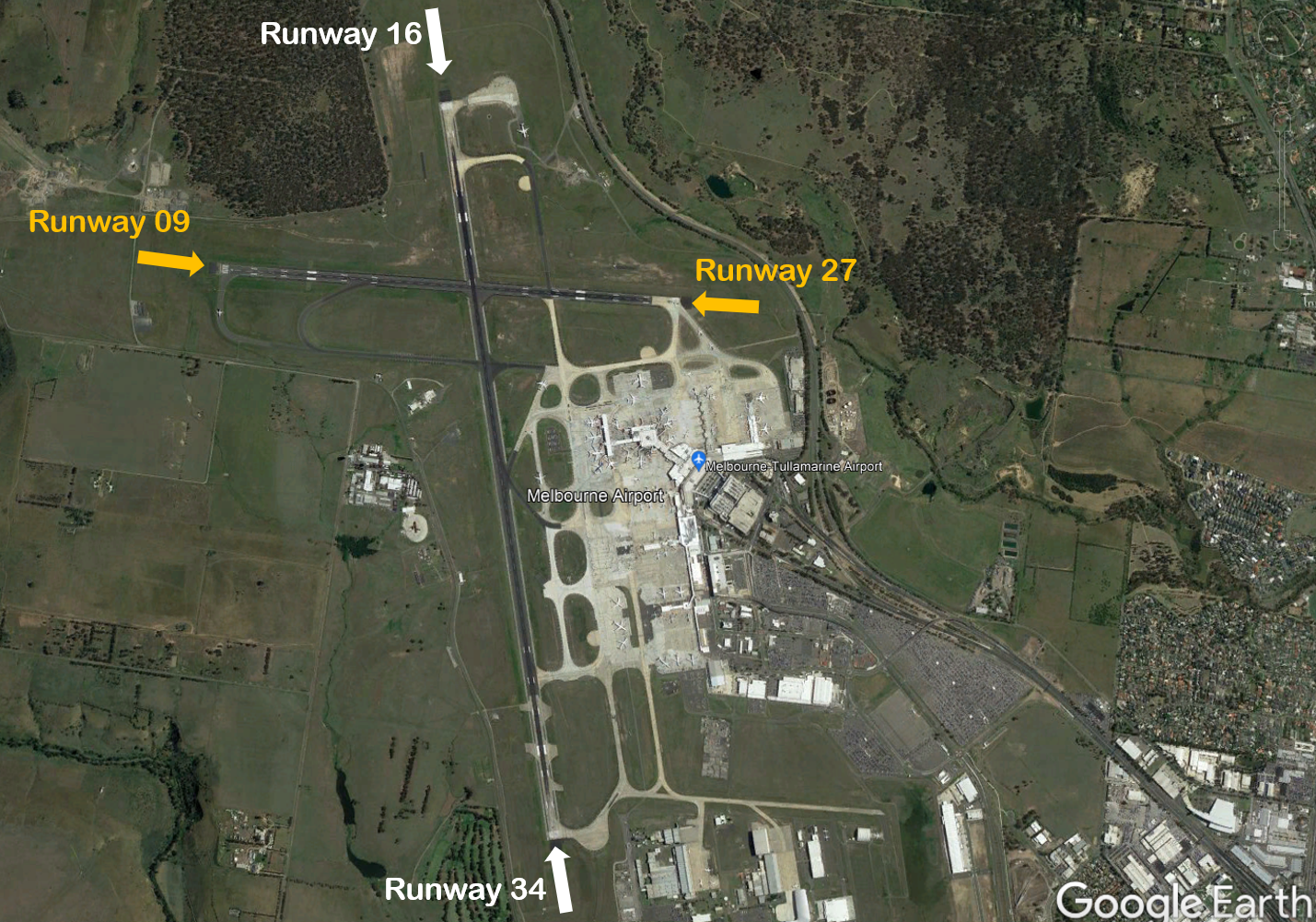
The following video explains how runways are named and used.
An Instrument Landing System operates for aircraft landing on Runways 16 and 27, and non-precision approaches are available to all runways.
Runway selection is based on wind direction, weather conditions, traffic volume and other factors. Aircraft primarily take-off and land into the wind for safety and performance reasons. Therefore, as the wind direction changes the runway in operation may also change depending on the strength of the wind.
This means that Melbourne’s seasonal wind patterns affect usage of the different runway directions. Specifically, Runway 16 tends to be used more frequently in the warmer months due to southerly winds whereas Runway 34 tends to be used more frequently in the cooler months when the predominant wind direction tends to be northerly. The pattern of use of Runway 27 tends to be less clear-cut as it can generally be used with either a northerly or southerly wind, provided the crosswind does not exceed the maximum allowed speed of 20 knots, including gusts.
Runways may be used in combination. For example, Runway 27 may be used for departures while Runways 27 and 34 are being used in combination for arrivals.
Noise abatement procedures are designed to help reduce the impact of aircraft noise on communities. While they are applied whenever it is possible to do so, their use is not mandatory and is subject to weather conditions and traffic requirements. Apart from weather, other operational factors can also necessitate using a particular runway e.g. some large heavy aircraft and long haul flights require the length of the north-south runway to take off or land safely.
The Melbourne Airport Noise Abatement Procedures (NAP) prioritise landings and take-offs over less populated areas to the north and west of the airport whenever possible. The NAP distributes the use of flight paths via the nominated runways to lessen noise intensity over any single area.
The NAP outlines that between 6.00 am and 11.00 pm, when there is not heavy traffic, Runways 16 and 27 are equally preferred for landing. Runway 27 used in combination with Runway 34, and Runway 27 used alone, are equally preferred for departures.
During busy periods between 6.00 am and 11.00 pm, Runways 27 and 34 used in combination and Runways 34 and 09 used in combination are equally preferred.
At night, between 11.00 pm and 6.00 am, the preferred runway for arrivals is Runway 16 and for departures is Runway 27.
Melbourne Airport uses the high capacity landing mode, LAHSO (Land and Hold Short Operations) on Runway 34 during peak periods when wind conditions allow. It is used to increase airport capacity during peak arrival periods when significant airborne delays would otherwise occur. In this mode, aircraft land on runway 34 and exit the runway before the intersection with the east-west runway 09/27, so both runways can be used at the same time with minimal disruption. Pilots may accept a LAHSO clearance provided that the pilot-in-command is approved to use the procedure and has determined the aircraft can safely land and stop within the available landing distance.
When high arrivals demand requires the use of LAHSO, or when wind conditions mean that only one runway can be used due to strong crosswinds, the priority runways will change accordingly.
In September 2024, the federal government approved the Major Development Plan (MDP) for the construction of the third runway at Melbourne Airport.
Melbourne Airport conducted public exhibition of the MDP from February to May 2022, giving the community an opportunity to provide feedback and utilise an interactive noise tool to explore future aircraft tracks. The proposal included detailed planning documents and considered the project’s impact on the community.
The MDP approval is subject to certain conditions on Melbourne Airport including:
We expect that the operation of the third runway will result in aircraft noise decreasing in some areas and increasing in others. Further community engagement will be undertaken by both Airservices Australia and Melbourne Airport throughout the flight path design process.
For more information on the third runway and upcoming consultation opportunities, please visit the Melbourne Airport website.
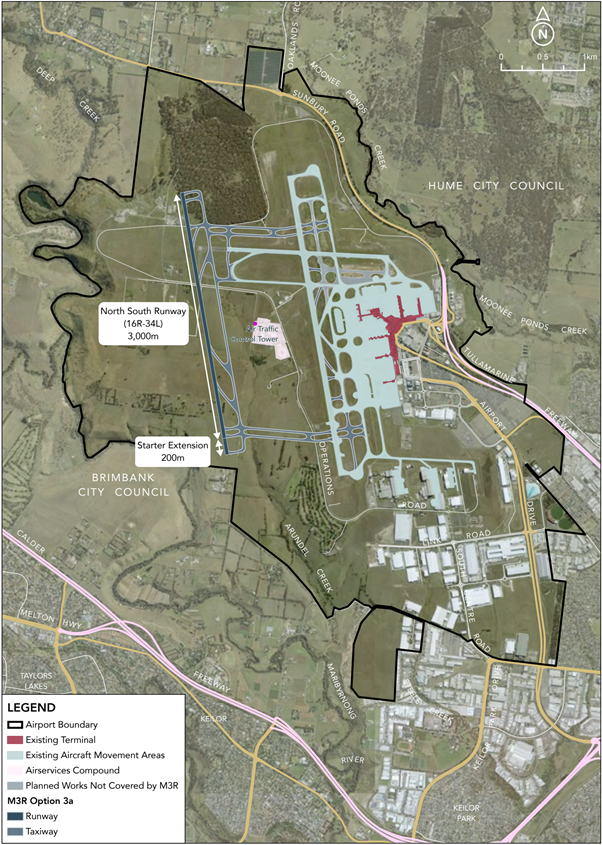
Cairns Airport currently has one operational runway: Runway 15/33. It is orientated north-south. The runway is 3196 metres long and has precision navigation aids at both ends enhancing the safe operation of aircraft landing from either the north or south.
The runway is referred to differently according to in which direction it is being used. For example it is known as Runway 33 when used in a northerly direction and Runway 15 when used in a southerly direction. Runway numbering reflects the runways’ orientation and correlates with degrees on a compass. Runway 33 is 330 degrees.
An Instrument Landing System operates for aircraft landing on Runway 15.
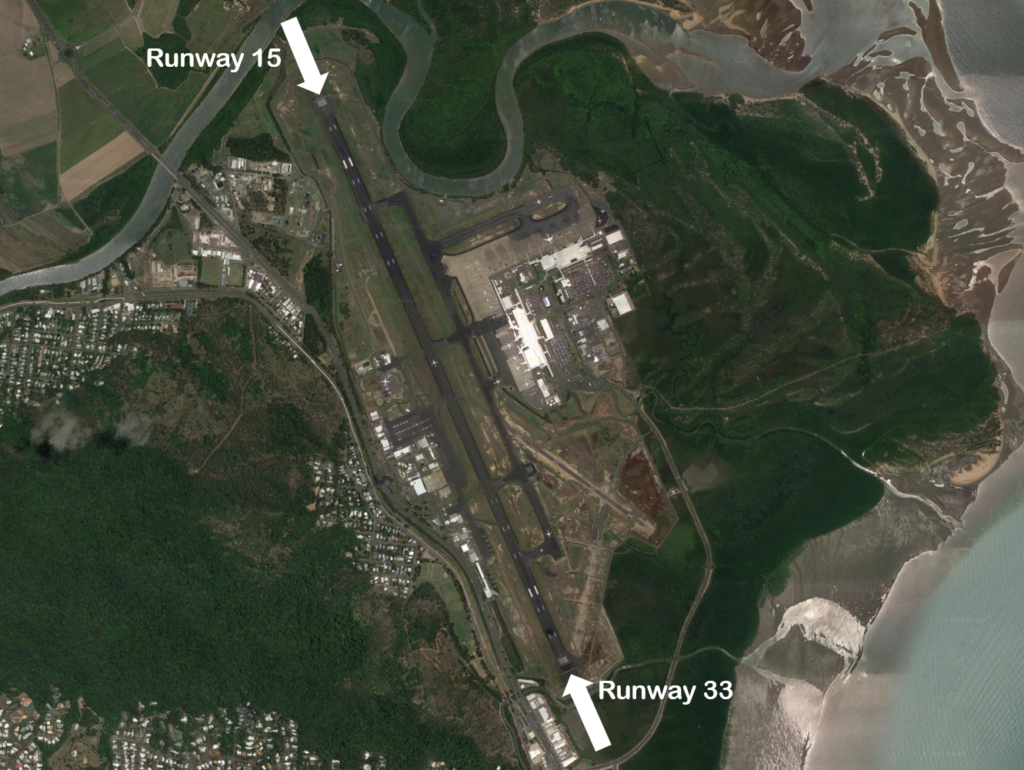
The following video explains how runways are named and used.
Runway selection is based on wind direction, weather conditions, traffic volume and other factors. Aircraft primarily take-off and land into the wind for safety and performance reasons. Therefore, as the wind direction changes the runway in operation may also change depending on the strength of the wind.
This means that Cairns’ seasonal wind patterns affect usage of the runway directions. The prevailing wind year-round tends to be southerly which results in more use of Runway 15. Therefore, when the wind direction is northerly and Runway 33 is used, it can be more noticeable to affected residents because it occurs less frequently.
Noise abatement procedures are designed to help reduce the impact of aircraft noise on communities. While they are applied whenever it is possible to do so, their use is not mandatory and is subject to weather conditions and traffic requirements.
The Cairns Noise Abatement Procedures outline that the preferred runway for landing and take-off is Runway 15. Arriving aircraft will be directed to use routes that are clear of highly populated areas until they are seawards of the coastline or established on their final approach to land. Pilots are asked to delay flap deployment until as late as is operationally practicable when on final approach.
Between 10.00 pm and 7.00 am, circuit training by jet aircraft (and other aircraft exceeding 5700 kilograms maximum take-off weight) is not permitted.
Between 11.00 pm and 6.00 am, no aircraft is permitted to conduct engine run ups (unless associated with the normal preparation of flight) without Cairns Airport permission. Operators and pilots of jet aircraft are also requested to cooperate in limiting the use of reverse thrust when landing.
Canberra Airport has two runways; the main runway 17/35 (3.28 km long) is orientated north-south and is used for the majority of aircraft traffic. The shorter runway 12/30 (1.67km) is orientated east-west and is used mainly for propeller aircraft.
Each runway is referred to differently according to in which direction it is being used. For example the main runway is known as Runway 35 when used in a northerly direction and Runway 17 when used in a southerly direction. Runway numbering reflects the runways’ orientation and correlates with degrees on a compass. Runway 35 is 350 degrees.
An Instrument Landing System operates for aircraft landing on Runway 35, and Smart Tracking procedures are available for aircraft landing on Runways 35 and 17.
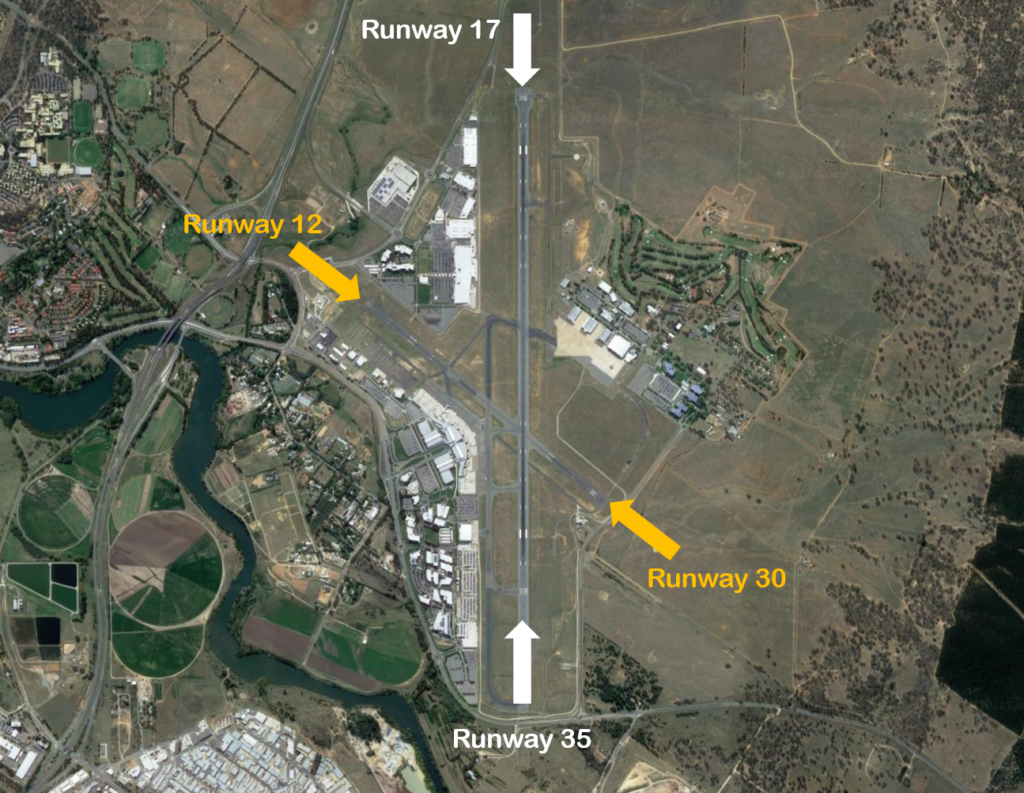
The following video explains how runways are named and used.
Runway selection is based on wind direction, weather conditions, traffic volume and other factors. Aircraft primarily take-off and land into the wind for safety and performance reasons. Therefore, as the wind direction changes the runway in operation may also change depending on the strength of the wind.
This means that Canberra’s seasonal wind patterns affect usage of the different runway directions. The prevailing winds favour Runway 35 which is used more than 70 per cent of the time. Runway 17 tends to be used more frequently in the warmer months than at other times, but this does vary.
A noise abatement area applies to most residential areas of Canberra and Queanbeyan. Aircraft will normally be routed to avoid the noise abatement area, which covers most of Gungahlin, North Canberra, Belconnen, South Canberra, Woden, Tuggeranong and Queanbeyan. Where it is not practical for aircraft to remain clear of those areas, during overflight jet aircraft must not fly below 7 000 feet above ground level and large propeller aircraft not below 5 000 feet. Smaller propeller aircraft are permitted. A number of exceptions apply to the noise abatement areas such as aircraft emergencies, medical priority flights, avoidance of hazardous weather, missed approaches and operational requirements.
Perth Airport has two runways; the main runway 03/21 (3.4 km long) is orientated approximately north-south and the smaller cross runway 06/24 (2.2km) is orientated south-west to north-east.
Each runway is referred to differently according to in which direction it is being used. For example the main runway is known as Runway 03 when used in a northerly direction and Runway 21 when used in a southerly direction. Runway numbering reflects the runways’ orientation and correlates with degrees on a compass. Runway 21 is 210 degrees.
An Instrument Landing System operates for aircraft landing on Runways 03,21 and 24, and non-precision approaches are available to all runways.
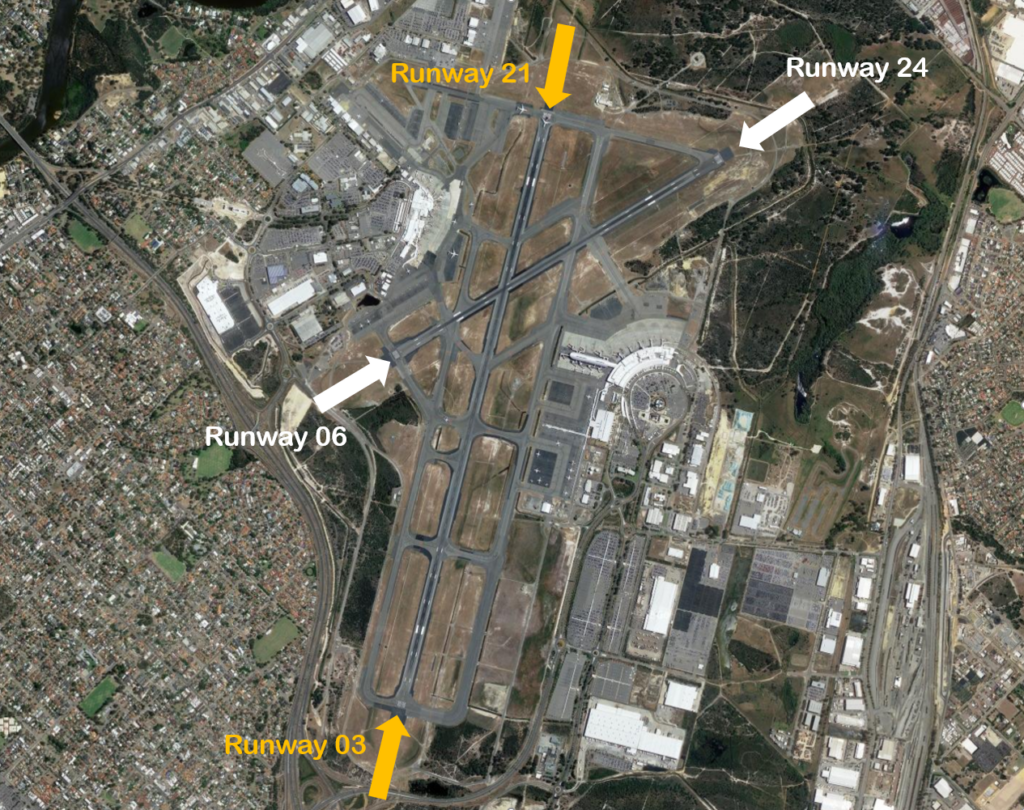
The following video explains how runways are named and used.
Runway selection is based on wind direction, weather conditions, traffic volume and other factors. Aircraft primarily take-off and land into the wind for safety and performance reasons. Therefore, as the wind direction changes the runway in operation may also change depending on the strength of the wind.
This means that Perth’s seasonal wind patterns affect usage of the different runway directions. Specifically, Runway 21 tends to be used more frequently in the warmer months due to southerly winds whereas Runway 03 tends to be used more frequently in the cooler months when the predominant wind direction tends to be northerly.
Runways may be used in combination. For example, Runways 03 and 06 may be used at the same time for departures, or Runways 21 and 24 may be used at the same time for arrivals.
One of the factors taken into account in runway selection is operational requirements. For example, two operational factors make Runway 21 a more suitable choice for departures during peak periods. Firstly, the location of the terminals and hangars in relation to the runways means that departing aircraft can be moved to Runway 21 more efficiently than to other runways. Secondly, because there is so much military restricted airspace to the north of Perth Airport, there is more airspace available to the south in which to manage the mix of slow and fast aircraft in the air after departure. Both these factors become critically important when the volume of traffic is high. For these reasons, Runway 21 will usually be selected in peak periods if the wind allows it. Therefore it can be expected that Runway 21 will be used whenever possible for the morning departure burst which is the busiest period at Perth Airport. This begins around 5 am.
Noise abatement procedures are designed to help reduce the impact of aircraft noise on communities. While they are applied whenever it is possible to do so, their use is not mandatory and is subject to weather conditions and traffic requirements.
The Perth Airport Noise Abatement Procedures (NAP) state that all runways are equally preferred for arrivals and departures with the exception of Runway 06 for landing and Runway 24 for departures. This is due to the very close proximity of residential areas to this end of the crossing runway. This runway end is used on occasion however, for example when there is too much crosswind to use the main runway, and when the main runway is unavailable for reasons such as runway works.
Although the NAP state the other runways are equally preferred, this does not mean that they are equally used – rather that there is no preference in the use of the runways from a noise abatement perspective and the weather and operational requirements will determine the preferred runway.
The procedures also provide that:
Melbourne Airport has a number of flight paths from its runways.
To learn more about the runways at Melbourne Airport, take a look at our Melbourne Airport Runway page.
The illustration below shows how jet and non-jet (turbo-prop) aircraft typically operate at Melbourne Airport on the published instrument arrival and departure flight paths.
The animation is indicative only and provided for information purposes, on occasion flights may leave these general areas.
Essendon Airport has two intersecting runways, one oriented north-south (Runway 17/35) and one east-west (Runway 08/26).
Each runway is referred to differently according to in which direction it is being used. For example, the north-south runway is referred to as Runway 35 when used in a northerly direction and Runway 17 when used in a southerly direction.
Runway numbering reflects the runways’ orientation and correlates with degrees on a compass. Runway 35 is 350 degrees magnetic.
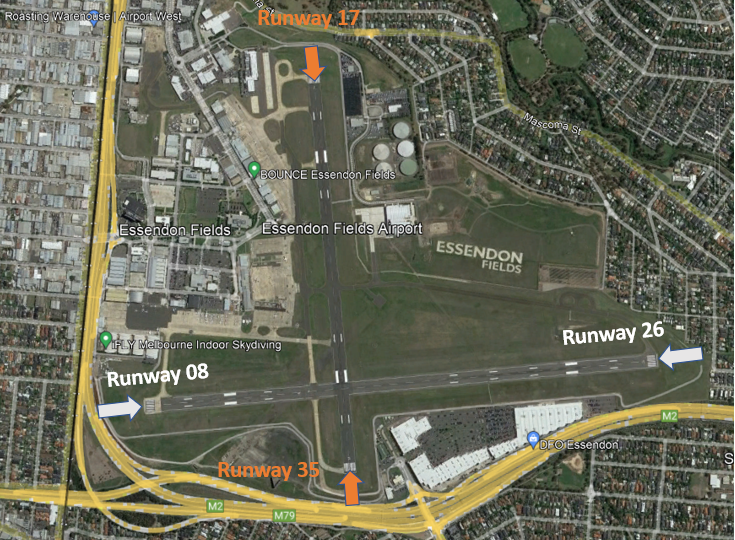
The following video explains how runways are named and used.
Runway selection is based on wind direction, weather conditions, traffic volume and other factors. See the Runway Selection page for more details. Aircraft primarily take-off and land into the wind for safety and performance reasons. Therefore, as the wind direction changes the runway in operation may also change depending on the strength of the wind.
This means that Melbourne’s seasonal wind patterns affect usage of the different runway directions. For example, Runways 35 tends to be used more often in the cooler months when there are frequent winds with a northerly component. Runway 17 tend to be used more frequently in the warmer months when the predominant wind direction tends to be southerly. Often the wind will also have a westerly component, such as a north westerly or south westerly, and for this reason Runway 26 is used frequently throughout the year.
A curfew that restricts both aircraft type and usage between the hours of 11pm and 6am applies. Certain classes of aircraft are permitted to operate during the curfew, including emergency services. More detail on curfew restrictions and dispensations is available on the Department of Infrastructure, Transport, Regional Development and Communications website.
Noise abatement procedures are designed to help reduce the impact of aircraft noise on communities. While they are applied whenever it is possible to do so, their use is not mandatory and is subject to weather conditions and traffic requirements.
The Essendon noise abatement procedures set out preferred runways at different times.
From 6:00 am to 11:00pm the preferred runways are:
From 11:00pm to 6:00am the preferred runways are:
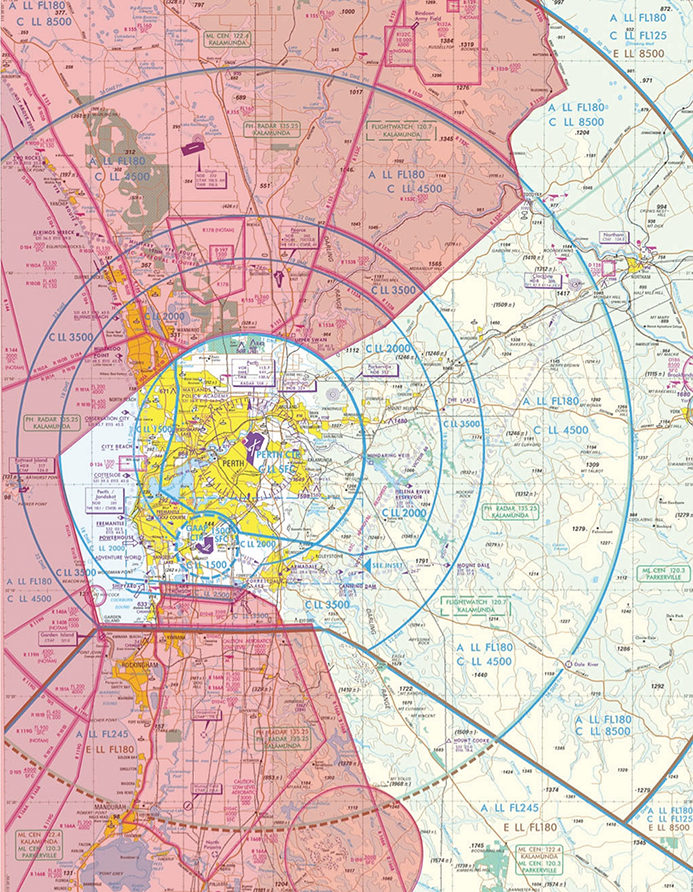
Flight paths for Perth Airport are designed around military airspace to the north, west and south, and Jandakot Airport airspace to the south. Military restricted areas are shown in pink in the image at right. Click to enlarge and use your back button to return to this page.
Military airspace (see image at right) can be active to ground level or it can begin at a certain altitude. Some military airspace is active only at certain times of the day and week. Where possible, flight paths are designed to remain under military airspace or to fly over the top of it. The close proximity of RAAF Base Pearce to the north means that air traffic controllers at Perth Airport have to coordinate their actions with RAAF controllers, including for changes of runway direction.
You can access historical information about flight path use through WebTrak. To access this information click the “Historical” link below the text in the Quick Start Guide at the top left-hand side of the screen. Then use the tick boxes at the bottom-right of the screen to select monthly, quarterly or yearly information. Use the sliders to refine your selection to specific timeframes.
To learn more about the runway at Perth Airport, take a look at our Perth Airport Runway page.
The illustration below shows how jet and non-jet (turbo-prop) aircraft typically operate at Perth Airport on the published instrument arrival and departure flight paths.
The animation is indicative only and provided for information purposes, on occasions flights may leave these general areas from time-to-time.
There are flight paths in and out of Essendon Airport for Instrument Flight Rules (IFR) aircraft and Visual Flight Rules (VFR) aircraft as explained below.
Because Melbourne Airport and Essendon Airport are in very close proximity, traffic at Essendon Airport sometimes needs to be managed in irregular ways to ensure that separation is maintained with Melbourne Airport traffic. Therefore at times you may observe aircraft flying in unusual ways.
A curfew that restricts both aircraft type and usage between the hours of 11pm and 6am applies. Certain classes of aircraft are permitted to operate during the curfew, including emergency services. More detail on curfew restrictions and dispensations is available on the Department of Infrastructure, Transport, Regional Development and Communications website.
Aircraft operating in Australia are required to meet noise standards imposed through the Air Navigation (Aircraft Noise) Regulations 201
Arrivals
Aircraft will approach Essendon Airport from all directions before they join the final approach path. Most arriving IFR aircraft will use standard arrival paths but some may be “radar vectored” by Melbourne air traffic control to intercept the final approach, that is, some aircraft may be given individual headings.
During inclement weather aircraft will usually make instrument approaches, which require the aircraft to be aligned with the runway in use 18 kilometres or more out from the airport as can be seen in the image of arrival flight paths below.
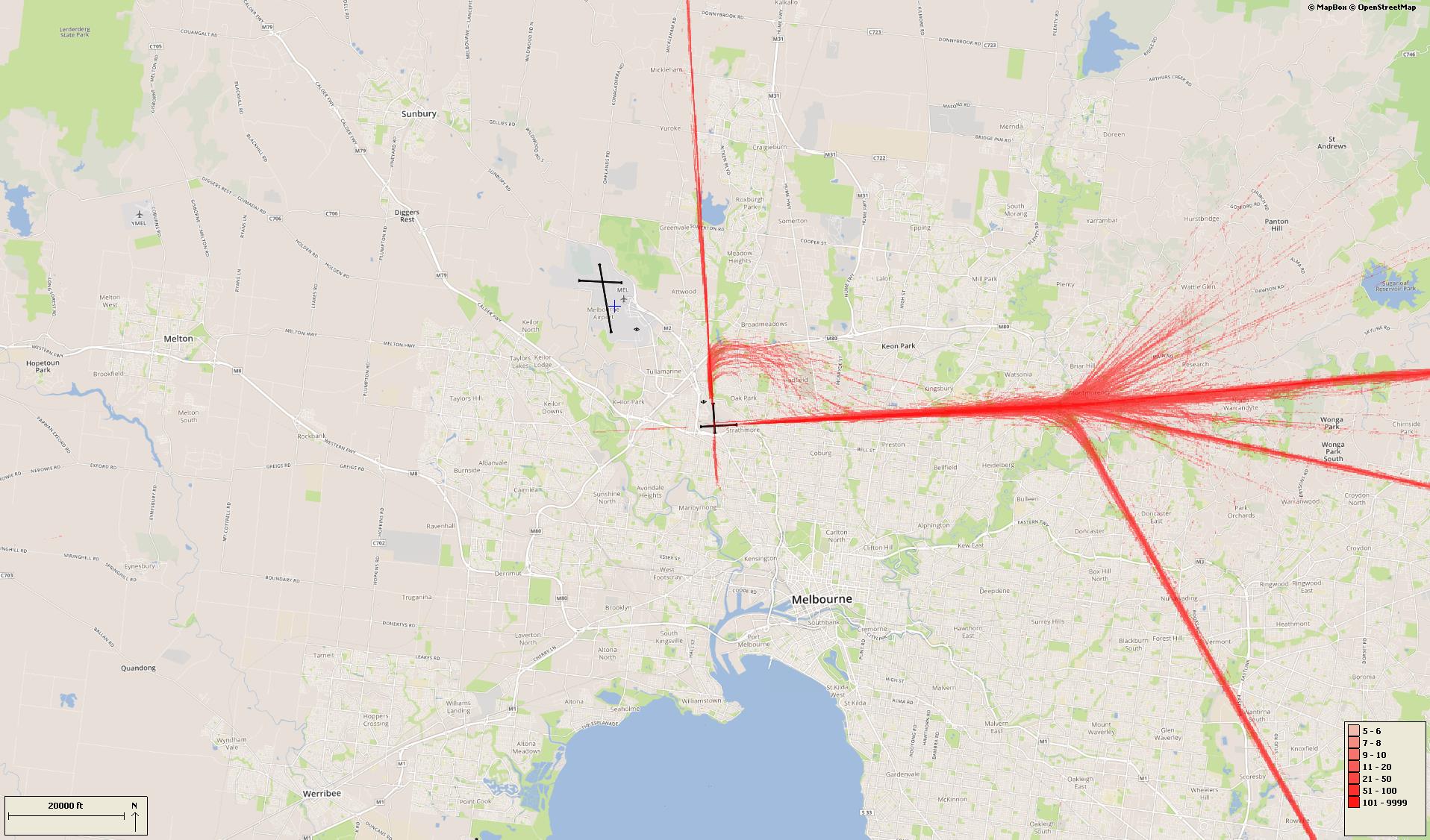
There is no minimum altitude for aircraft in the process of landing. Aircraft will generally descend on a glide slope of three degrees.
Aircraft departing Essendon Airport must be kept separated from aircraft departing and arriving Melbourne Airport. In most cases Essendon departures will be turned away from Melbourne Airport after take-off. Some aircraft may be directed to turn off the runway heading sooner than others. This usually occurs for traffic management reasons to ensure that safe separation is maintained between aircraft.
The altitude of aircraft after departure will depend on factors such as the type of aircraft and its weight, how heavily laden it is with fuel and passengers, and the atmospheric conditions at the time. All these factors affect an aircraft’s climb rate. There is no regulated minimum altitude for an aircraft in the process of taking off.
There are designated routes for Visual flight Rules (VFR) aircraft to ensure that this traffic remains separate from aircraft flying under Instrument Flight Rules such as jets and most commercial aircraft. It is not mandatory that VFR aircraft fly these routes, but many do, especially as they approach or depart airports.
These routes are mainly outside controlled airspace (“OCTA”), that is, aircraft are not being directed by air traffic control. Whenever they fly outside controlled airspace, pilots are following the rules of the air. More information about airspace is found here.
VFR routes include defined entry and exit points to and from controlled airspace. These are landmarks that are easily seen by the pilot from the air.
Aircraft inbound from the north may track via Craigieburn. Those from the north-east may track via Yan Yean Reservoir and Epping. When inbound from the east aircraft may track via Doncaster Shopping Centre and then either north or south of the airport or direct to the airport depending on which runway is in use.
Aircraft inbound from the south-east may track via major visual tracking points such as Albert Park and Station Pier or Westgate Bridge and then either via Moonee Valley Racecourse or direct to the airport.
From the south-west and west some aircraft will track coastal and via Laverton Bureau of Meteorological Tower, then get a clearance to track via Station Pier or Westgate Bridge and then via Moonee Valley Racecourse or direct to the airport.
The image below shows VFR and IFR arrival routes and the average percentage each VFR route is used.
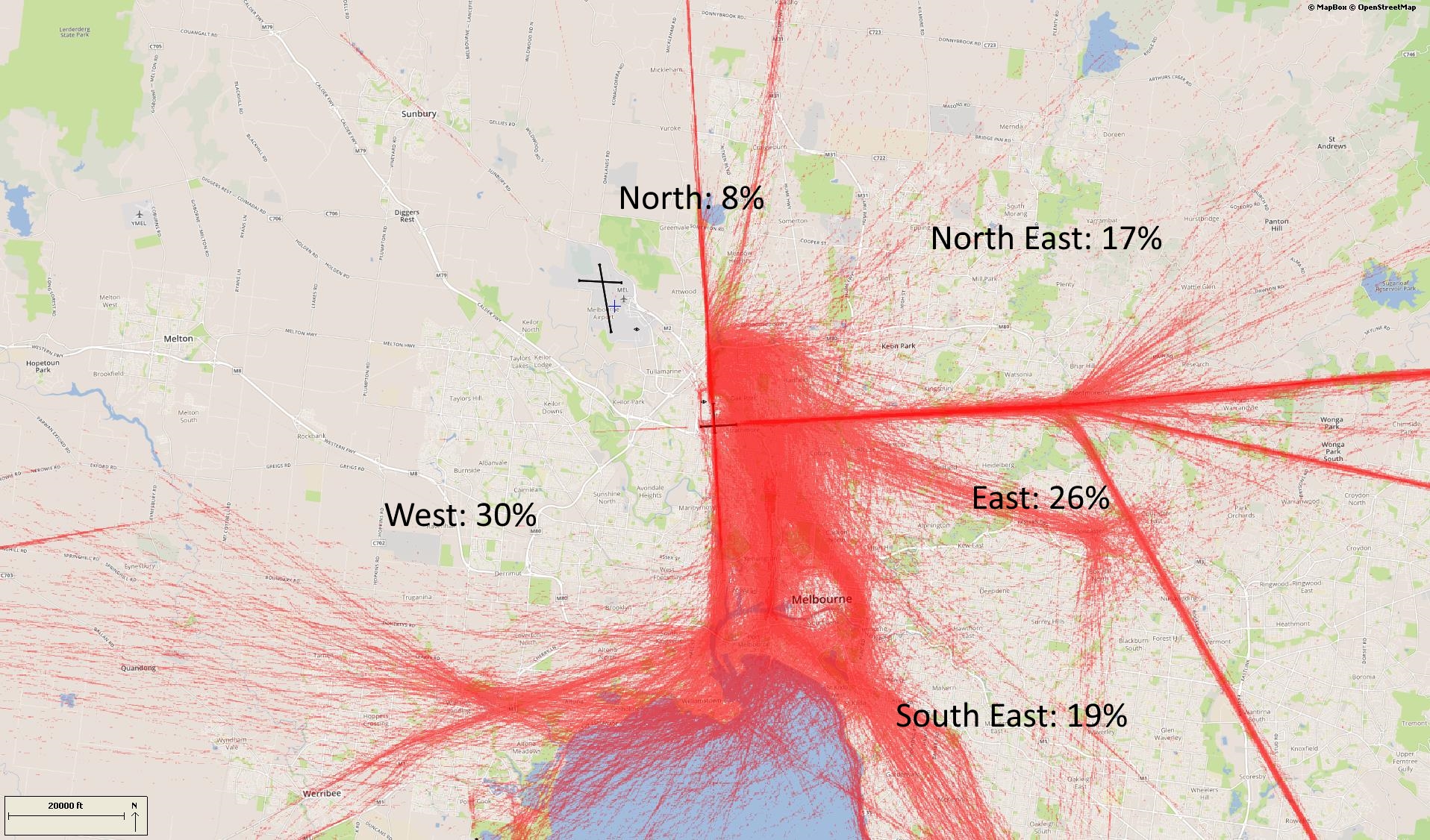
Outbound VFR aircraft will be cleared via one of the visual tracking points towards their destination.
The image below shows VFR departure routes and the average percentage each is used.
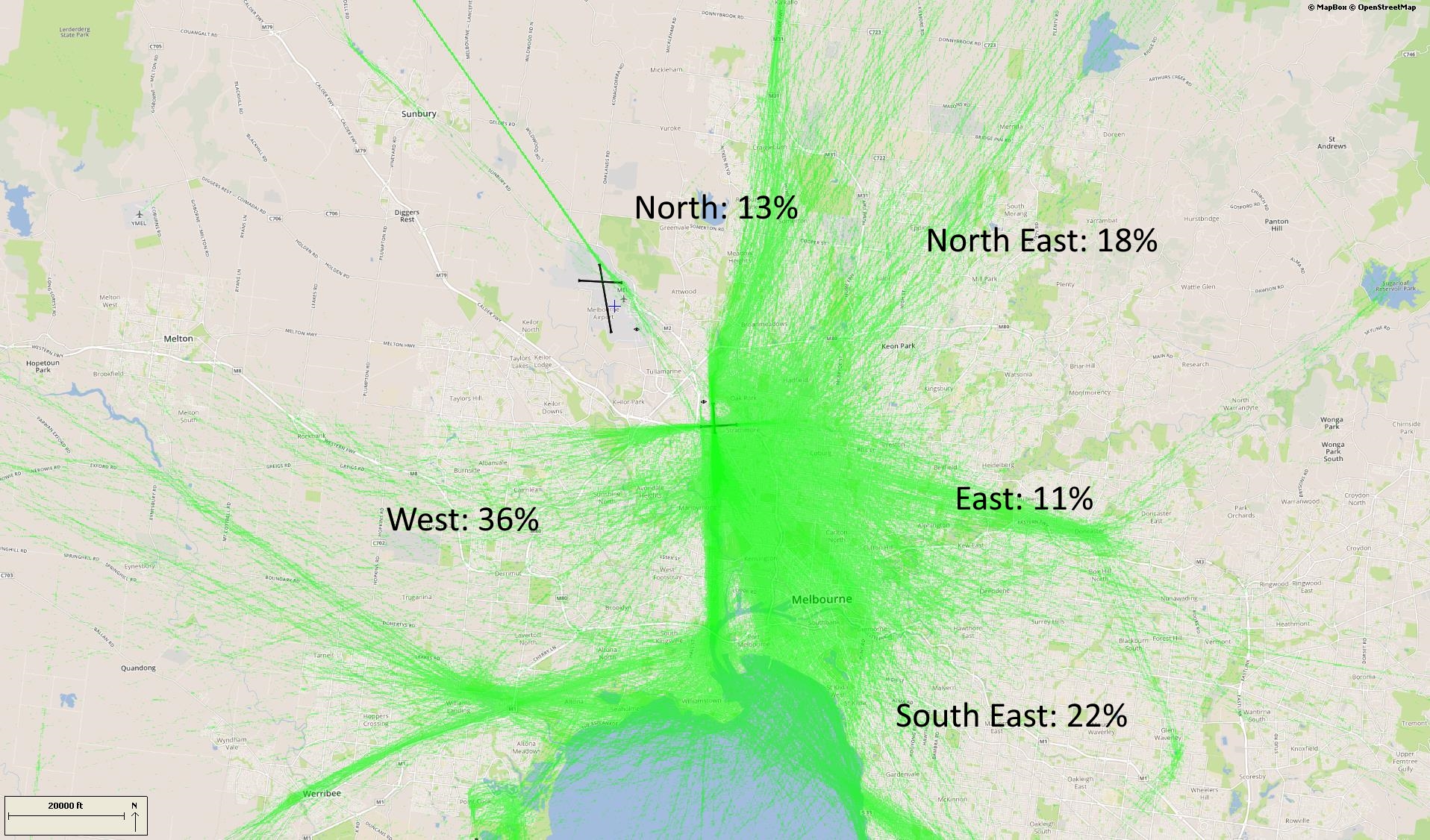
The coastal route runs from Carrum to the south of Moorabbin Airport and around to Altona South. This allows aircraft to track around the city and the Bay while keeping outside controlled airspace and therefore not needing a clearance from air traffic control. A large number of light aircraft use this route.
Aircraft may use the coastal route to access the training area south-east of Moorabbin Airport, or the training area near Point Cook.
A number of helicopter and fixed wing operators conduct scenic flights from Essendon Airport and Moorabbin Airport. The main scenic route sees the aircraft flying an orbit over the area around Docklands, Eureka Tower, Rod Laver Arena, the MCG and AAMI Stadium, Exhibition Building, and Eureka Skydeck 88.
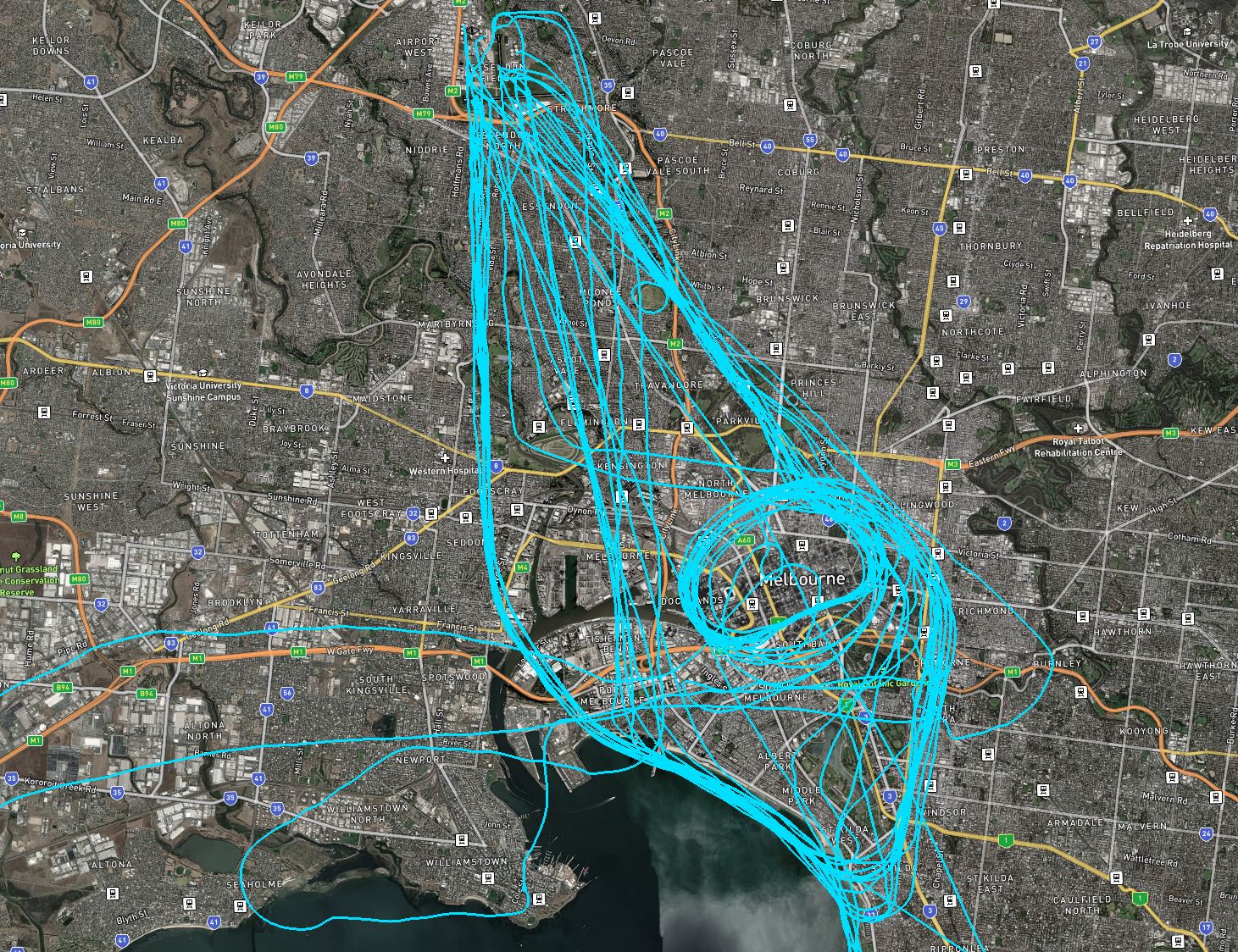
Other scenic flights head out of Essendon over Flemington Racecourse towards Port Philip Bay. This is followed by a coastal flight and then an orbit of the Docklands / MCG area. As shown in the image, above, routes can vary.
Flights are conducted at 1000 feet altitude over residential areas and 500 feet over water. Operators may choose to fly higher however in the area immediately around Essendon Airport and over the CBD passenger aircraft operate in the airspace directly above which limits the level scenic flights can ascend to.